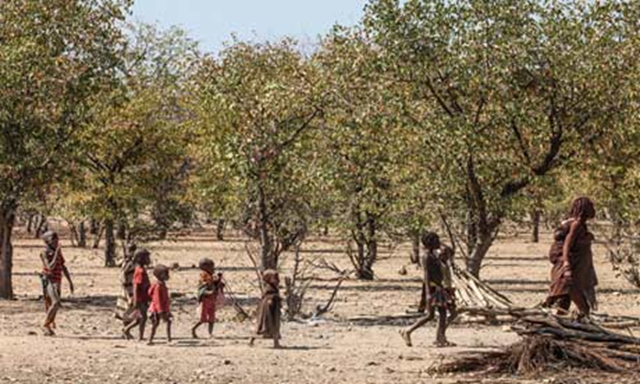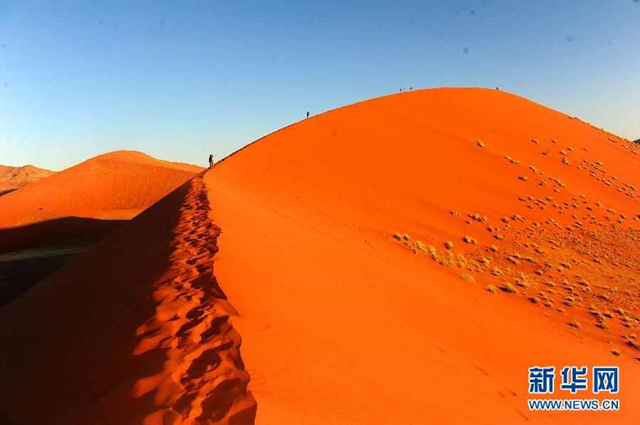Video: Namibians face starvation in worst drought in a generation – Elephants and other desperate wildlife gather around remaining puddles and faucets in human camps
By Max Fisher
13 August 2013 (Washington Post) – The United Nations Children’s Fund released this short video from Namibia, a country in southwestern Africa that’s twice the size of California, documenting the effects of the country’s most severe drought in decades. It’s a national emergency, and the United Nations is getting involved. Here are a few facts about what’s happening in Namibia right now:
- With crops drying up, there are 780,000 people, or one in three Namibians, officially classified as “severely or moderately food insecure,” which means that they can’t count on consistent access to food.
- The statistic above includes an estimated 105,000 children under age 5.
- Hunger is already a problem for Namibian children, 29 percent of whom have stunted growth for want of sufficient nutrition. That affects permanent physical and mental development.
- As many as 400,000 people may be at risk of going hungry, up from 300,000 in May.
- The government warns that there may not be enough water for the country’s people, much less its livestock, which could lengthen the crisis.
- Aid groups say they are underfunded.
- Namibia is normally very dry and so it is especially susceptible to the effects of climate change. Mark Leon Goldberg, who writes the blog UN Dispatch, called the drought there “yet more evidence that the poorest people on the planet are most vulnerable to global climate change.”
Namibia is in the middle of its worst drought in 30 years. This is what it looks like on the ground. 
By David Smith
14 August 2013 (The Guardian) – One in three people in Namibia is at risk of malnutrition, the UN has warned, as the driest country in sub-Saharan Africa endures its worst drought for a generation. The government declared a state of emergency after the failure of crops in May and pledged $20m (£13m) of relief for the worst-hit households. The Kunene region in the north has had no rain for two years, and families have been forced to sell livestock and migrate to cities in search of work. After a summer lacking rains and a typically dry southern hemisphere winter, Unicef, the UN’s children agency, has appealed for millions more to tackle the situation. “An estimated 778,000 Namibians, a third of the population, are either severely or moderately food insecure,” said Unicef, noting that this includes 109,000 under fives. “Against a backdrop of underlying fragility, including pre-existing high levels of food insecurity and maternal and child undernutrition (29% national stunting) combined with low sanitation coverage (14% in rural areas), children and women are particularly at risk of worsening health and nutrition status given the current drought conditions,” the agency added. Unicef has appealed for $7.4m (£4.8m) to support efforts to respond to the needs of women and children affected by the drought. The International Federation of Red Cross and Red Crescent Societies (IFRC) is asking for $1.48m (£1m). On Monday, an Associated Press (AP) report described how the drought has struck the village of Orupembe, forcing residents to go elsewhere in search of water and grazing ground for their livestock. More or less the only people left in the village, once home to 400, are about 20 police officers, said AP. “They left for the other side of the mountain, looking for water for the cows,” Olani Imanul, the chief of police, told AP. “It has not rained for over two years here.” The drought is being described as Namibia’s worst for 30 years, and some have been quick to blame climate change. When Namibia’s president, Hifikepunye Pohamba, declared a state of emergency in May, he said: “It has now been established that climate change is here to stay and humanity must find ways and means of mitigating its effect.” Crop production in some areas was expected to decrease by about 50% because of the lack of rain, he added. Mark Leon Goldberg, author of the UN Dispatch blog, posted a video about the drought, observing: “Yet more evidence that the poorest people on the planet are most vulnerable to global climate change.” [more]
Namibia drought: one in three at risk of malnutrition 
Orupembe, Namibia, 12 August 2013 (SAPA) – The police are about the only people left in this village of 400 in the Namibian desert because the infrequent rains have ceased due to a drought, forcing residents to seek precious water and grazing ground elsewhere for their livestock. “They left for the other side of the mountain, looking for water for the cows,” said Chief of Police Olani Imanul, whose roughly 20 officers feel a tad useless with just about everyone gone. “It has not rained for over two years here.” Summer rains usually flood the plains and rejuvenate the flora, but they did not come. Now, in the Southern Hemisphere winter, it is especially dry. UNICEF said the drought in this arid corner of southwest Africa is said to be the worst in three decades and that families are selling assets such as livestock, have less to eat and are migrating to cities to find work. “An estimated 778 000 Namibians, a third of the population, are either severely or moderately food insecure,” UNICEF said in an online report on Wednesday. One of those affected is Jormany Mupetami, who sells semi-precious stones outside the village of Uis to tourists. His dreadlocks and his smile make the visitors at ease. Yet, even after making a sale for US$50 he whispers, almost embarrassed: “Would you have some canned food you could give us for the children?” “It has now been established that climate change is here to stay and humanity must find ways and means of mitigating its effect,” Namibian President Hifikepunye Pohamba said in May as he declared a state of emergency as a result of the drought. He said crop production in some areas was expected to decrease by about 50 percent below average because of the lack of rain. At the Van Zyl pass community camp, skinny cows fight with birds for water at the camp’s faucet. The Ombuku river is dry and has been for the past two years. Outside Purros, a hamlet graced by giant sand dunes in the midst of a mountainous Martian landscape, a river has been reduced to a narrow stream. Desert elephants, oryx, baboons, and springbok gather around a few puddles of water along with skinny livestock, seeking relief in the heat of the day. The Namibian government in May committed about US$20.7 million to provide food and water to affected people and called on the international community to assist, UNICEF said.